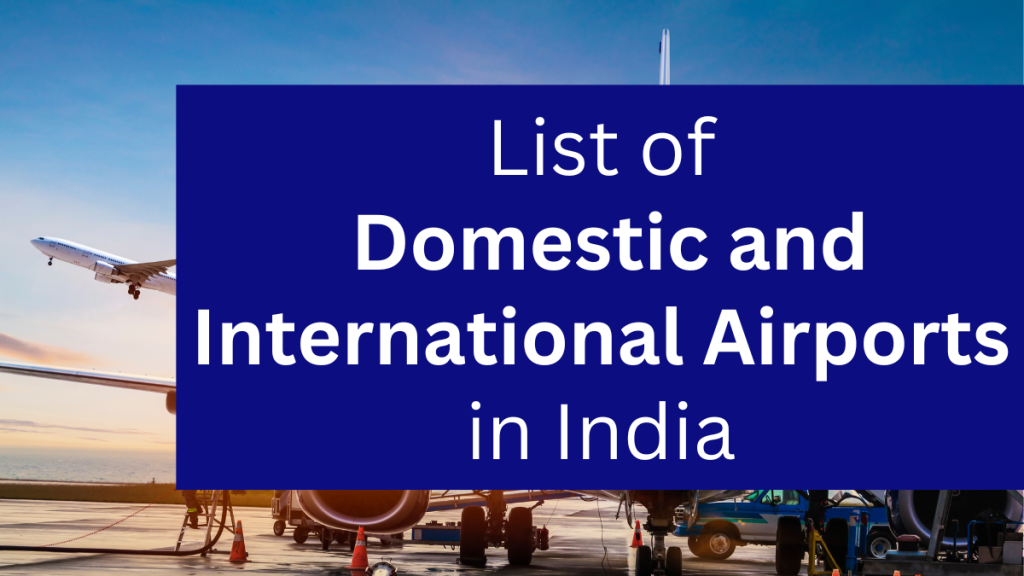The Indian aviation sector plays a very important role in bridging its vast geography and connecting our country with the rest of the world. As its economy is growing fast, so is the demand for air travel. Thus, it has developed a substantial network of airports, which comprises domestic airports in India as well as international airports in India. These airports play a very important role in developing trade, tourism, and cultural exchange. Millions of passengers benefit by traveling between urban centers and remote regions conveniently, accelerating economic development and regional connectivity.
Currently, India has 148 airports operated by AAI, besides private operators in a public-private partnership. Out of those, 108 have been classified as domestic and 40 have been categorized as international in nature and serving international destinations worldwide. The above illustration depicts that the importance of India has increased in the international sector, and therefore, the need for the improvement in its air travel system arises.

International airports in India encompass world-class places that have a service like Delhi’s Indira Gandhi International Airport or the Chhatrapati Shivaji Maharaj International Airport that is located in Mumbai which takes up all of international passenger and cargo movements into India. Domestic airports include Pune, Jaipur, and Guwahati, linking up smaller cities within the country and developing activities within regions.
Besides, government schemes such as UDAN scheme are also targeting the expansion of air connectivity to the underserved regions in India. Hence, it is supporting India’s aviation sector. With new airports in pipeline, the total number of airports in India will continue growing, paving way for air travel convenience and thereby boosting the economy of India. Whether it is the question of how many international airports in India or the broader role of aviation, India’s record in this area is a very important and telling one.
Through this blog, we will give you an overview of the important domestic and international airports in India. You can read on to know more about the airports in India.
How Many Airports Are in India?
India has already put into operation 148 airports in its total network by 2024. Out of all of these, nearly 108 of them are domestic and 40 of them are international airports. These become infrastructure where millions of passengers travel in the country and cross its boundaries without any hassle. In terms of the number of airports in India, you should be aware that they have actually increased over the years. You can see it as a reflection of the country’s interest in air travel with the gradual growth in the economy.
The Airports Authority of India (AAI) manages most of these airports, ensuring smooth operations and efficient management Many others are being run on the PPP model which is the public-private partnerships. Prime examples of such airports are Delhi, Mumbai and Hyderabad amongst others. This has resulted in better airports with increased capacity along first-class passenger services for air travel. All this just means that India is rapidly growing in the aviation sector as visible in the rising number of air travel passengers over the years. The growing number of facilities is also a direct result of the demand for connectivity between tier-2 and tier-3 cities.
All this simply means that regional connectivity will also be developed further with initiative like the UDAN Scheme . Ultimately, this would mean that the coming years will see a definite increase in the number of airports in India. This is a development that we dearly need as air travel is becoming accessible to more and more people in the country, irrespective of their class. Such developments are of great importance to make air travel accessible to all sections of people and aid the nation in furthering economic growth and overall development at the regional level.
International Airports in India
International airports in India are testaments to the strength of the aviation infrastructure in India and the increasing connectivity of the world. The critical gateway of these airports connects the continent to India and provides entry points for passenger and cargo transport. With 40 international airports in India, it can manage the increasing air traffic of the country.
These are world-class infrastructural and operational efficiency hubs, and there are a few of these. A few of these are Delhi Indira Gandhi International Airport, Mumbai Chhatrapati Shivaji Maharaj International Airport, Kempegowda International Airport in Bengaluru, and Cochin International Airport in Kerala, which is a fully solar-powered airport and is the first in the world, which proves the innovative and sustainable efforts in India.
International airports in India greatly help the Indian economy; even encouragement is given to trading, tourism, and culture. It deals with millions of international passengers and huge cargo every year. This, therefore, makes it a very important participant in the world of aviation. More numbers of international airports are in process and are being taken up day by day, not just to meet the increased requirement for international travel but also to strengthen international relationships. This growth supports India’s presence globally as well as supports economic and social development. International airport key facts:
Major International Airports and Interesting Facts About them
Let’s take a look at the few major international airports in India. We have also provided you with a list of facts about them below:
Indira Gandhi International Airport (Delhi)
Indira Gandhi International Airport based in Delhi is the country’s busiest airport and a huge hub in global aviation. Countless millions pass through its gates each year, making it among the world’s top airports. It is both an entrance point for domestic travelers and international travelers due to its world-class infrastructure and connectivity.
Chhatrapati Shivaji Maharaj International Airport (Mumbai)
Chhatrapati Shivaji Maharaj International Airport is based in Mumbai. One of the country’s busiest airports, it allows both passenger and cargo traffic through outstanding cutting-edge infrastructure and the brilliant design of the terminals. Its efficiency makes it renowned and a hub for key financial capital for India.
Kempegowda International Airport (Bengaluru)
It is Karnataka’s first fully solar-powered airport and also the green energy hub of this world. It is one of the busiest airports in town for professionals going to and coming back from the Silicon Valley of India because it is the largest business and technology center in the world.
Chennai International Airport (Chennai)
Chennai International Airport is one among the most important entry ports to southern India. Cultural richness of the region makes that region a gateway to another culturally rich region of the world. Strategically located, it also deals with a big quantity of passengers and cargo in terms of international trade and tourism for Tamil Nadu.
Netaji Subhas Chandra Bose International Airport, (Kolkata)
Netaji Subhas Chandra Bose International Airport is located in Kolkata. It is the region’s primary airport for the service sector of eastern India. It is a key hub for regional and international flights as part of catering to business and tourism in this economically and culturally active region.
Rajiv Gandhi International Airport, (Hyderabad)
This Hyderabad airport is synonymous with the use of state-of-the-art technology and operational efficiency. The southern India major hub comes directly linking Hyderabad to the rest of the world through international destinations, hence making it well positioned for the growing business and IT industries.
Cochin International Airport, (Cochin, Kerala)
Cochn International Airport towers at Kerala. It is the world’s first fully solar-powered airport, with considerable international passenger and cargo traffic passing through the facility, making it a good example of sustainable infrastructure promoting green energy on a global scale.
Goa International Airport, (Dabolim )
Goa International Airport, or Dabolim Airport, is the main entry point for international tourists to India’s prime beach destination. Serving the critical function of connecting this tourism-driven economy to key international and domestic destinations, it plays a vital role in supporting the economy of Goa.
Sardar Vallabhbhai Patel International Airport (Ahmedabad)
Sardar Vallabhbhai Patel International Airport is the key airport serving Gujarat and connects Ahmedabad, located in the state. Known for its modern facilities and efficient operations, this international airport supports the thriving industrial and business sectors of the state and also connects the region with the rest of the world.
Thiruvananthapuram International Airport, (Kerala)
Thiruvananthapuram International Airport is one of the significant international gateways of Kerala. Located at the state capital, it accommodates a volume of passengers to the Middle East and Southeast Asia supporting tourism and the expat population of Kerala.
Another interesting fact is that the busiest international airports in India are Delhi, Mumbai, Bengaluru, and Chennai. These airports enjoy considerable demand both in terms of passenger and cargo traffic. They are very essential places for India’s global trade, tourism, and connectivity and provide world-class infrastructure and services.
Domestic Airports in India
India’s domestic airports connect the big metropolitan cities to small towns, rural, and remote areas. It helps millions of passengers who travel from one corner of the country to another with smooth travel, least wastage of time, and for regional development and economic growth. With the development of connectivity through domestic airports, air travel becomes easy, convenient, and facilitates industries such as tourism, agriculture, and trade, bridging the vast geographic distance across the length and breadth of the nation. Some major domestic airports you need to know are:
Juhu Airport (Mumbai)
Juhu Airport, located in Mumbai, is India’s oldest airport, primarily used for domestic and regional operations. Established in the 1920s, it serves as a hub for private flights, helicopters, and general aviation, reflecting its historical and operational significance.
Pune Airport (Maharashtra)
Pune Airport operates as both a civilian and military airbase. It is managed by the Airports Authority of India and the Indian Air Force. Located in Lohegaon, it caters to both domestic passengers and defense operations, making it important for the aviation facility.
Jaipur International Airport (Rajasthan)
Jaipur International Airport may be an international airport, but it is also a central factor in domestic air travel for Rajasthan. Jaipur airport connects the state capital to all the major Indian cities. It also has an important role in tourism and trade. That makes it an important part of the state’s architectural and cultural heritage.
As mentioned earlier, India does have a total of 108 domestic airports. The ones we have mentioned are just some of the ones with an important factor attached to it.
New Developments in Indian Aviation
The Indian aviation sector continues to expand with significant new developments aimed at enhancing connectivity and promoting economic growth. Among the key projects is the Noida International Airport, which is under construction in Uttar Pradesh. Once operational, it is expected to become a major hub in northern India, alleviating traffic from Delhi’s Indira Gandhi International Airport and supporting regional growth. Similarly, Kushinagar Airport, recently inaugurated in Uttar Pradesh, aims to boost tourism, particularly religious tourism, as it is located near significant Buddhist pilgrimage sites.
India currently operates 108 domestic airports, providing critical connectivity to remote and economically important regions. These domestic airports are instrumental in linking smaller towns and rural areas to major urban centers, fostering regional development. This extensive network supports industries like tourism, agriculture, and trade, playing a key role in India’s overall economic growth.
The Indian government has launched initiatives like the UDAN Scheme (Ude Desh ka Aam Nagrik) to make air travel affordable for the common citizen. By connecting underserved and unserved airports, the scheme promotes regional connectivity and encourages growth in air travel demand. Additionally, upcoming projects such as greenfield airports are expected to further increase the total number of airports in India, ensuring seamless travel access across the country.
Private Partnerships
Public-private partnerships are another driver of growth in India’s aviation infrastructure. Airports such as Delhi, Mumbai, and Hyderabad operate under these models, ensuring improved efficiency, service quality, and infrastructure standards. These collaborations have set benchmarks for operational excellence and have contributed to India’s emergence as a major aviation hub.
Together, these developments underline India’s commitment to strengthening its aviation sector, supporting economic growth, and enhancing global connectivity. The table given below lists some of the important airports, both domestic and international in India. Keep in mind that we have not listed all the 150+ airports in India, but have listed only a handful o the most significant ones.
| Type | Airport Name | Location | Interesting Facts |
| Domestic Airport | Juhu Airport | Mumbai, Maharashtra | Oldest operational airport in India |
| Pune Airport | Pune, Maharashtra | Dual-use for civilian and military operations | |
| Lokpriya Gopinath Bordoloi Airport | Guwahati, Assam | Key hub in Northeast India | |
| Birsa Munda Airport | Ranchi, Jharkhand | Regional connectivity in eastern India | |
| International Airport | Indira Gandhi International Airport | Delhi | Busiest airport in India |
| Chhatrapati Shivaji Maharaj International Airport | Mumbai, Maharashtra | Iconic design and high passenger traffic | |
| Kempegowda International Airport | Bengaluru, Karnataka | Known for sustainability and solar power | |
| Cochin International Airport | Kochi, Kerala | First fully solar-powered airport in the world |
Summing Up
The airports in India, both domestic and international, highlight the nation’s impressive strides in aviation infrastructure and connectivity. With 148 operational airports, including hubs like Delhi, Mumbai, and Cochin, India is fostering economic growth, tourism, and global business ties. The country’s aviation sector continues to expand, supporting millions of travelers while enhancing its standing as a key global player. The future of India’s aviation promises even greater connectivity and innovation.
ixamBee specializes in providing expert guidance and resources for banking exams 2024, ensuring that you are well-prepared for the Upcoming Bank Exams like RBI Grade B, NABARD Grade B, IBPS SO, and more. Our courses align with the bank exam calendar 2024, covering all the essential topics. With a focus on the upcoming bank jobs, our Previous Year Papers, BeePedia, SSC CGL, SSC CHSL, SSC MTS and other Mock Tests are designed to help you excel in upcoming banking exams.
Also Read :
List of Major Crops and Producing States in India
National Symbols of India 2024: Learn Their Meaning and Significance
List of Wildlife Sanctuaries in India: Discover Nature’s Hidden Gems












![Ramsar Sites in India [Updated 2022]](https://ixambee.com/blog/wp-content/uploads/2022/03/3-218x150.png)

